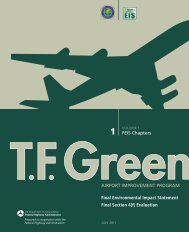Ch 2 Precision Approach Feasibility - PVD
Ch 2 Precision Approach Feasibility - PVD
Ch 2 Precision Approach Feasibility - PVD
Create successful ePaper yourself
Turn your PDF publications into a flip-book with our unique Google optimized e-Paper software.
North Central State Airport<br />
<strong>Ch</strong>apter 2 – <strong>Precision</strong> <strong>Approach</strong> <strong>Feasibility</strong><br />
Airport Master Plan<br />
FINAL<br />
fact, the LPV approach will require no ground based equipment at the airport other than the existing<br />
Localizer antennae.<br />
WAAS is a navigation service using a combination of Global Positioning System (GPS) satellites and the<br />
WAAS geostationary satellites to improve the navigational service provided by GPS. The system is owned<br />
and operated by the Federal Aviation Administration (FAA). WAAS is known to improve the navigational<br />
system accuracy for en route, terminal, and approach operations over all the continental United States.<br />
This new navigational technology supports vertically-guided instrument approaches to all qualifying<br />
runways in the U.S. Vertically-guided approaches reduce pilot workload and provide safety benefits<br />
compared to non-precision approaches. As mentioned, vertically-guided approach procedures (called LPV)<br />
can provide ILS equivalent approach minimums as low as 200 feet at qualifying airports. Actual minimums<br />
will be based upon SFZ’s current infrastructure, as well as an evaluation of any existing obstructions. The<br />
current lowest minimums to Runway 5 are 400 foot ceiling and ¾ mile visibility, as illustrated in Figure 2.1<br />
on the next page.<br />
2.1.1 Advantages of an LPV <strong>Approach</strong><br />
There are many advantages of a WAAS-enabled LPV approach. They are:<br />
• LPV procedures have no requirement for ground-based transmitters;<br />
• As a result, the often difficult task of siting ground based navigation equipment is eliminated, as<br />
well as providing and maintaining critical areas around the facility, or providing access for<br />
maintenance vehicles;<br />
• From a pilot’s viewpoint, an LPV approach looks and flies like an ILS, but the WAAS approach is<br />
more stable than that of an ILS; and,<br />
• WAAS equipped users can fly area navigation (RNAV) and basic required navigation performance<br />
(RNP) procedures, as well as LPV procedures, and the avionics costs are relatively inexpensive<br />
considering the total navigation solution provided.<br />
• Provides the opportunity to reduce the existing weather minimums, allowing better access to the<br />
airport during inclement weather conditions.<br />
Rhode Island Airport Corporation<br />
The Louis Berger Group, Inc. March 2010 - Page 2-2















